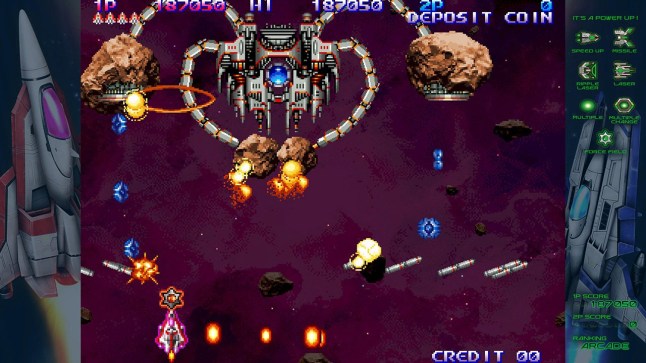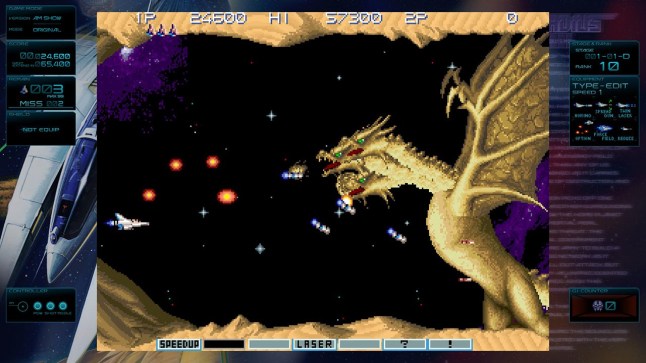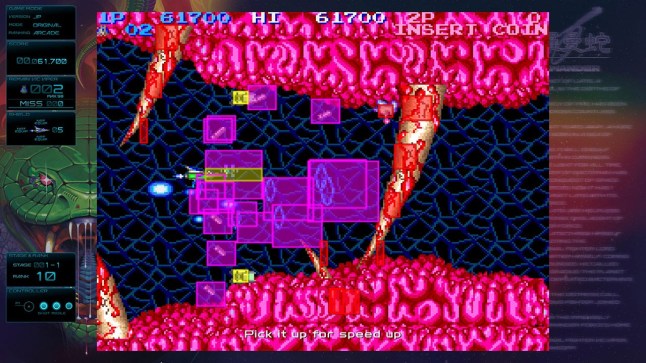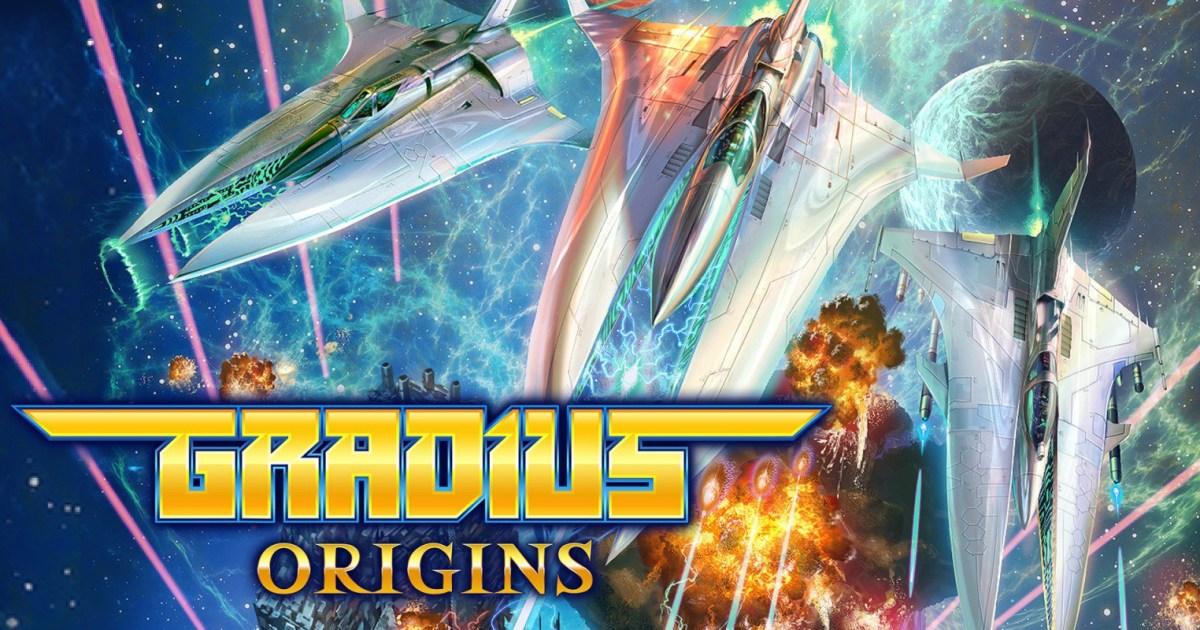
Gradius Origins – a new Salamander is a dream come true (Konami)
Konami and M2 present a new compilation of classic Gradius titles, which also includes a brand new sequel for one of the best 2D shooter series of the 80s and 90s.
For the longest time it seemed as if Konami had given up being a traditional video game publisher, after they pushed out Hideo Kojima and essentially stopped making new titles. The company isn’t in trouble, it’s just that it makes plenty of money through its casinos, health clubs, and other media, such that the risks of the current video games industry probably don’t seem worth the while.
However, a decision must’ve been made a few years ago to start engaging once again, with cautious attempts to bring back everything from Contra to Survival Kids, with remakes and remasters ranging from Metal Gear Solid to Ninja Five-O. Some of their choices seem very strange (why so many new Silent Hill games but only a few remaster collections for Castlevania?) but it’s great that they are starting to make an effort again.
We didn’t expect Gradius to be a priority but given our love for 2D shooters we’re very glad to see it get its turn in the spotlight. Especially as this compilation focuses on sister series Salamander – which is our particular favourite – and brings with it an entirely new sequel that’s been created by emulation masters M2.
The release of a new retro compilation is always a double-edged sword, as it’s always guaranteed to come with at least one of two problems, and usually both. Either it misses out lots of notable entries in the franchise, for no obvious reason, or it doesn’t include any museum content to explain what the games are and where they sit in a historical context.
We’re happy to say that Gradius Origins does have some very nice production and concept art for most of the games, showing the initial concepts for the iconic Vic Viper spacecraft and early designs for levels and enemies. Unfortunately though, there’s little in the way of descriptions (or, god forbid, a documentary) to help anyone that’s not already a fan understand what any of it is or the amount of effort M2 has gone to.
Gradius was by no means the first horizontally scrolling 2D shooter but the original entry from 1985 set a new standard for the genre, that has been followed ever since, including by the likes of Darius and R-Type. It coined the term ‘shoot the core’, in reference to the first mini-boss, and pioneered an unusually versatile power-up system, where you collect tokens as you fight and use them as and when you need to activate specific abilities, from faster speed to missiles or lasers.
Expert, exclusive gaming analysis
Sign up to the GameCentral newsletter for a unique take on the week in gaming, alongside the latest reviews and more. Delivered to your inbox every Saturday morning.
You can also pick a set menu of power-ups before you start the game, that you’re still able to activate in any order, allowing for a great deal of strategy and flexibility. Each game has a different approach to the same idea but there’s only actually three Gradius games in this compilation: the original (aka Nemesis), 1988’s Gradius 2 (aka Vulcan Venture), and 1989’s Gradius 3.
The other four games are all Salamander titles, a spin-off series that begin in 1986, when it was known as Life Force in the US, and until now has only had one mainline sequel, in 1996’s Salamander 2. Although the games work in the same basic way as Gradius they’re quite distinct, in that they include both horizontal and vertical levels and feature co-op play.
Each of the Salamander games also emphasises biological enemies and levels, such that we’ve always imagined that you’re battling vast Lovecraftian monsters in the outer dark. Salamander has a more traditional power-up system than Gradius, but it’s more generous when you die, as you restart exactly where you left off and you can pick up the power-ups you just lost.

This Gradius 3 boss was only in an early prototype version (Konami)
Although just to complicate things, there is the 1987 version of Salamander, which was essentially a director’s cut and which was named Life Force even in Japan. It’s the only entry to feature a Gradius style power-up system, which is an interesting novelty and one of the highlights of this collection.
That version of the game is included as a separate title, but all the other games have multiple versions, including Japanese and international editions, post-launch updates, and even previously unreleased prototype versions. At least one of these, the one for Gradius 3, M2 has recreated from lost assets, including a giant dragon boss that wasn’t in any of the official versions.
However, these are all only the original arcade versions and there are no console games at all, not even the NES version, which was famously the first ever to feature the Konami code. You do get a modern version of that though, in an impressive array of difficulty modifiers, including save states you can activate at any time, a rewind feature, and an invincible and easy mode for all but Salamander 3.
There’s also a separate training mode that lets you automatically rewind to practice difficult sections. This is on top of a mountain of additional options that allow you to change how many lives you start with and modify the difficulty – up and down – in excruciatingly minute detail. You can even turn on and off bug fixes, including slowdown that the original arcade hardware was prone to.
Salamander 3 review
That’s just what you’d expect from developer M2, whose involvement immediately eliminates any question as to the quality of the emulation. They don’t often make brand new games, but Salamander 3 makes you wish they did. It limits itself to the technology of what looks like the mid-90s, so it’s not a major step beyond any of the other games. In fact, it’s arguably less advanced than Salamander 2, which has a lot of pre-rendered graphics (which have aged surprisingly well).
Salamander 3 is tightly designed, with a very fast pace to the action, and while there are some stages that are obvious nods to existing ones there are a lot of neat ideas, like the vertical stage where you’re shooting your way through asteroids and unearthing buried moai, or one where you’re getting pulled in by the gravity of mini-planetoids.
Despite the pixel-only graphics, Salamander 3 does take advantage of the increased power of modern consoles, in terms of the amount of enemies on screen at once. It’s not quite a bullet hell shooter but it comes close, especially as your own ship has a limited use burst weapon which spews dozens of bullets at 360°. Even the music is good, with some neat chiptune tracks by chibi-tech.
As Salamander fans (that sounds weird, but we never liked the name Life Force) this compilation is an unexpected gift but in terms of the core Gradius series there’s a lot missing. Even if you accept that it’s only arcade versions – which rules out Treasure’s excellent Gradius 5, PS1 game Gradius Gaiden, two MSX exclusive titles, and several portable titles – there’s no Gradius 4, which was an arcade game.
WiiWare title Gradius ReBirth is also absent, despite it also being developed by M2 and currently being unavailable on any format, so we can only hope that there is at least one more compilation after this. Whether Konami feels Gradius deserves that kind of attention we’re not sure but while we accept the 2D shooter genre is a niche one these are all great games, that were highly influential at the time of their original release.
But if this is it then we’re perfectly satisfied; Salamander 3 is an excellent retro sequel and while we’d love to see a big budget adaptation of the series, with modern gameplay and graphics, that’s almost certainly not going to happen. But perhaps that’s just as well, as when we interviewed producer Ryosaku Ueno we were impressed by his answer about that possibility, where he compared 2D shooters to classical music, and how it would be absurd to expect it to transition into modern pop songs.
We’d still like to see some evolution of the concept but if retro gaming really is akin to classical music, then Gradius and Salamander are the Brandenburg Concertos of the 2D shooter genre.
Gradius Origins review summary
In Short: A loving tribute to Gradius and its spin-off series, with some of M2’s best archaeological work and an excellent retro sequel in Salamander 3.
Pros: Arcade perfect conversions, with an insane level of customisation options and difficultly aids. Salamander 3 is excellent and the previously unseen prototype versions are an unexpected bonus.
Cons: The lack of explanation and context for the museum content is a shame. A lot of missing games from the series.
Score: 9/10
Formats: PlayStation 5 (reviewed), Nintendo Switch, Xbox Series X/S, and PC
Price: £34.99
Publisher: Konami
Developer: M2 (originals by Konami)
Release Date: 7th August 2025
Age Rating: 7

You can even make the hit boxes visible if you want (Konami)
Email gamecentral@metro.co.uk, leave a comment below, follow us on Twitter.
To submit Inbox letters and Reader’s Features more easily, without the need to send an email, just use our Submit Stuff page here.
For more stories like this, check our Gaming page.
Comments
Arrow
MORE: Why is Sony trying to kill the concept of the video game console? – Reader’s Feature
Arrow
MORE: GTA Online will add age verification to comply with UK laws claims insider
Arrow
MORE: Battlefield 6 ‘doesn’t need Nicki Minaj’ says dev in knock against Call Of Duty
GameCentral
Sign up for exclusive analysis, latest releases, and bonus community content.

